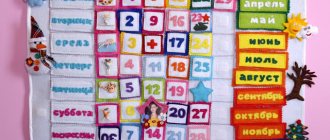How to tell children about the rules of safe behavior on the street
Be an example The first and most important thing: in the presence of a child, parents themselves must strictly observe the safety rules that they practice with their son or daughter. As an example: you should not cross the road at a red light, run into the closing doors of a vehicle with your child, or take a shortcut by passing through construction sites. And under no circumstances should you violate this principle by explaining it as haste, “one time”, and so on.
Let's not leave him alone The child does not have enough life experience that can tell him how to behave in a new, unfamiliar environment. Therefore, naturally, you cannot leave him alone. It is necessary to talk through any situation that is new to the child, especially a conflict or traumatic situation. You must be patient when answering numerous children's questions, repeating over and over again the rules of behavior that you want to teach.
Choosing words It is extremely harmful to use phrases like: “If you behave badly, a policeman (evil uncle, robbers, etc.)”, “Now I’ll go home, and you’ll stay here!” From these phrases, the child does not gain any new experience or information, but only concludes that he can be given to someone or left for nothing. He loses his sense of safety, security, and importance for his parents.
Also, you should not use explanations like: “bad”, “bad”, “not good”. These are too abstract concepts that don’t tell a child anything. We must try to explain why it is bad to do this or that way and what dangerous consequences this or that method of behavior may have.
Be patient When talking about safety, you should avoid overly negative emotional overtones. Due to psychological characteristics, the child will create a hopeless-catastrophic picture in his mind.
Conversations about safety should be carried out in the form of a regular conversation that accompanies the daily joint activities of the child and the parent, for example at an intersection: “Do you see the red man? He stands and we stand. And now it’s green, it looks like it’s walking, which means we can cross the road too.”
Games and poems are used. To reinforce information, you can use rules set out in poetic form, for example: “Red light - no road, yellow - get ready, and green says: go ahead, the path is open!”
Children learn about the world through play, when they try on different roles and play out different life events. To assimilate and remember, you should use games that play out potentially dangerous life situations. Such games of “life” are a great way to teach your child about the basic principles of safety, and together with him to find optimal and safe ways to get out of such situations.
It is very convenient to explain traumatic situations in such a playful form: behavior near construction sites, pits, open wells and windows, railway tracks, not forgetting to draw the child’s attention to this on the street whenever possible. zzzz
All of the above works provided that parents are interested in the safety of their child, patiently answer all children's questions and do not brush them aside. And they treat the process of education as a guarantee of their well-being, and not as a burden that prevents them from going about their business.
A balanced emotional state of a parent is the key to ensuring that the child will be open to accepting new information. In such a state, you can explain to him how he can behave and how he cannot. Feeling safe, the son or daughter will not be afraid and will not be injured.
Also, we should not forget about interactive programs, cartoons and children's literature dedicated to safety issues. Using these materials in the process of joint activities with children.
“Parents play the main role in shaping the rules of safe behavior. They are the ones who are responsible for the physical and psychological safety of their children, since by definition they are the main significant people for the child,” says Alexander.
Conversation “Safety on the street and at home”
Conversation on the topic:
"Safety on the street and at home."
Target:
deepen and systematize students’ knowledge about the rules of safe behavior and ways to get out of dangerous situations.
Tasks:
To help students develop a conscious need to maintain their health.
Develop the ability to analyze possible dangerous life situations and the ability to make the right decision.
To promote in students attentiveness, responsibility for their actions, and resourcefulness.
Progress of the conversation.
Introductory speech by the teacher.
Every person wants his rights not to be violated and to feel safe. We want to believe that the majority of people in the world, in our country, in our city are respectable citizens who are guided by the principles of morality and morality, act according to their conscience, take into account the opinions of other people, do not violate their rights, and obey the law. If every person lived and behaved like this, then there would be no need for police, courts, or prisons. But, unfortunately, this picture is far from reality. Various crimes and offenses are constantly being committed in the world. None of us are immune from any crime being committed against us. Preventing trouble is always better than looking for a way out of the current situation later. There is a proverb: “Forewarned is forearmed.”
How do you guys understand this proverb?
(Children's answers may be as follows: when a person knows what can happen, he is ready for it, has time to react, has the necessary information, can prepare physically and mentally).
That’s why today we’ll talk about what can happen on the street, what dangers may lie in wait for you and how you should behave.
What dangers do you think might await you on the street?
(Children’s answers may be as follows: aggressive young people, high school students, peers can cause harm, maniacs, drug addicts, we can “get into history” if we go far from home, to an unsafe place, we can get lost, etc.).
Today you and I will arm ourselves with the necessary knowledge in order to avoid all these dangers, and if something happens, then you will know how to act correctly, how to behave.
First of all, it is necessary to observe safety measures:
Curfew.
Children are prohibited from being in public places unaccompanied by adults from 23.00 to 6.00 (in winter - from 22.00). A child who walks in public places at night is returned to his parents or persons replacing them. In this case, adults bear administrative responsibility. If the child does not have parents or the adults responsible for him do not contact him within three hours, the minor is placed in the nearest specialized institution for children in need of social rehabilitation.
What other security measures can you name?
(Children’s answers may be: do not walk along deserted streets, do not get into cars with strangers or unfamiliar people, have protective equipment with you, etc.).
General safety precautions:
Pedestrian traffic rules, like traffic rules, must be strictly followed.
Never accept gifts, money, sweets, invitations to ride in a car, etc. from strangers. It is especially dangerous to agree with them to go somewhere, travel, provide them with any help (for example: bring things, find a cat, dog, take a photo, etc.).
Nowadays, when terrorist attacks occur very often, be extra careful on the street: do not touch or open unfamiliar objects: packages, bags, packages. And if you find suspicious objects, then inform the adults who are close to you, or immediately call the rescue service. Whatever happens to you on the street, first of all tell your parents or other close people.
Safety rules and self-defense.
What you see in the movies may not always give you the correct ideas about self-defense. For example, a girl walks past cars parked in the parking lot. Suddenly some guy jumps out from behind the SUV and rushes at her. The girl hits the bad guy in the eyes with her keys or kicks him in the groin. While he writhes in pain, she runs away.
This movie. In life, everything looks different: when a girl is about to strike a villain with her hand or foot, he, knowing what awaits him, grabs her by the hand (or leg) and throws her off balance. Enraged by her attempts to resist, he throws her to the ground, and now she has virtually no chance to defend herself.
In a dangerous situation, the main thing is to do everything possible to avoid fighting and fighting when someone threatens or attacks us. Self-defense is the use, first of all, of the mind, not the fists.
Teenagers (boys and girls) who are under threat of physical violence and intend to fight back may actually make the situation worse. An attacker who is already mentally prepared can become completely uncontrollable and cruel. Therefore, the best way to deal with an attack or threat of attack is to try to avoid it. This way, you are at the least risk of causing yourself physical and mental harm.
One way to avoid a potential attack is to trust your instincts. Your intuition, combined with common sense, can help you get out of trouble. For example, if you are jogging in the park and suddenly feel like you are being followed, perhaps your intuition is telling you that something is wrong. Your inner voice tells you that it is best to return to where there are more people around. Listen to him!
Intruders aren't always strangers who jump out of dark alleys. Unfortunately, teenagers can also be attacked by people they know.
In a dangerous situation, you need to speak or act in a way that prevents the situation from getting worse. For example, giving your money to a robber instead of fighting or running. If someone is following you on the street and tries to talk to you when no one is around, you can delay the attack by agreeing with them and engaging in dialogue. You can then redirect your opponent's attention (“Oh, there are my parents!”) and calmly resolve the situation.
In order for a girl to avoid unsafe attention to her person, there is no need to provoke him in the first place.
A short skirt, tight blouse, and bright makeup are quite appropriate in situations that do not involve undesirable consequences. You can look like this at a house party, a school party, or in the company of very close people.
However, you need to remember, for example, that according to statistics, a large percentage of sexual assaults occur precisely from acquaintances and close friends. Sexual predators make up only a small percentage of rapists.
It is better to come to various kinds of youth gatherings (parties) not alone, but with close, trusted friends. You have to leave with them, no matter how great the desire to dance and have fun. In the old noble etiquette there was a recommendation “not to give a reason.” This recommendation today constitutes the first condition for a girl’s safe behavior.
Not only a girl’s appearance, but also her behavior can give a reason. Cheerfulness, loud laughter, or other displays of emotion attract the attention of others. And if some people perceive such behavior as a manifestation of bad manners, others perceive it as a sign of accessibility.
Recommendations for girls (also suitable for boys):
– do not be on the street alone in the dark;
– avoid passageways, courtyards, uninhabited areas, and territories;
– do not use the underground passage if it is poorly lit or sparsely populated;
– never, under any circumstances, get into a car with strangers or unfamiliar people;
– never, under any circumstances, enter other people’s houses or apartments on your own, even if you are earnestly asked to do so (you need help, babysit, call);
If you still have to walk alone in the dark or through a deserted place, take the following safety measures:
– clothes should not restrict your movements;
– shoes should be comfortable for running; high-heeled shoes should not be worn;
– hair should not be loose (loose hair can easily be wrapped around your hand in case of physical violence);
– You should have personal protective equipment with you.
Recommendations for young men
(tips to prevent a fight)
– do not behave defiantly;
– do not demonstrate arrogance, superiority, or contempt to others;
– do not bully the people around you, even if you really want to demonstrate your prowess in front of your companions, and especially your female companions. Firstly, this will not elevate you in their eyes, and secondly, you don’t know who you’ll run into;
– do not openly carry things with you that have great material value; they may be of interest to lovers of easy money;
– be vigilant, try to avoid meeting with a large company, tipsy or drunk people;
– avoid deserted places if you are walking alone, and even more so if you are accompanying a girl. In the first case, you can still escape, in the second, this option is excluded;
– try to avoid physical confrontation until the last moment;
– when aggression is shown towards you, stay calm and confident in yourself. Both extremes of behavior are undesirable: your counter-aggression can only provoke the attackers; your humiliatingly begging position will inevitably put you in the position of a victim. A person who behaves like a victim is in all situations the target of an attack;
- if a fight is inevitable, the main thing to understand is: only people with an inferiority complex, offended by life and people, fight to the bitter end (the exception is the defense of a child, a woman, a disabled person, when there are no other methods of defense left). A real man will find a way to stop a fight as soon as possible.
- Take self-defense lessons. The best way to prepare for an unexpected attack from the outside is self-defense classes. A self-defense instructor will teach you how to properly assess an extreme situation and decide what to do to resolve it. He will teach you special techniques to stop an attacker's aggression and other things you can do to get out of trouble unscathed. For example, attackers usually anticipate that their victim may be hit in the groin or eyes. A good instructor will teach you ways to surprise an aggressor and take him by surprise.
The most important thing that a self-defense practitioner will gain from training is self-confidence. The last thing you need to think about during an attack is: “Can I really do this?” It is much easier to take action in an emergency if you have previous training experience.
Self-defense lessons will give you the opportunity to practice techniques and combat tactics. If you attend training with a friend, you can continue to practice on each other at home to retain the techniques in your muscle memory and mind even after the training is over.
What to do if it was not possible to avoid danger? If, for example, you are walking along a dark street and feel that someone is following you, chasing you? Children's answers may be as follows: you need to run away, scream, call for help, try to turn onto a more crowded and well-lit street (if possible), go to a store or pharmacy.
Change your route, take a different road (as long as it is not deserted). Pretend that you forgot something and turn back, stop to adjust your clothes, shoes, etc. (this way you will check if you are really being followed or confuse the attacker), change your behavior, be unpredictable, turn sharply to face the person and ask “What do you want?” / “Why are you following me?”
Try not to enter the entrance or elevator with suspicious people; wait for other people to enter there.
When you see a group of young people ahead who may be aggressive, when passing by them, behave confidently, but not defiantly, look straight ahead (not at the floor - the look of the victim, but not into the eyes - a defiant look).
If something has ever threatened you or is now threatening you, and if this danger comes from someone you know, someone close to your parents (which often happens), then be sure to tell your parents about it.
How to get out of dangerous situations? The teacher suggests situations, and students discuss ways out of them.
A boy (young man) walks along an unfamiliar street in the evening; a group of guys blocks his way. What should a boy (young man) do? No need to wait for them to say something, start acting (if you see that they are aggressive). It’s better to turn off the road, take a different path, go to the nearest store or pharmacy, talk on the phone - play a role - as if someone is coming to meet you, for example, your older brother or dad should meet you, speak louder so that the intruders can hear. In a critical situation, show all your acting abilities: you can pretend that you recognize this person (the offender), as if he were your old friend, and begin to behave accordingly. This will help distract the offender, mislead him and you can leave or run away. If you understand that you can simply run away, then it is better to do just that. This is not a shame, this is a necessary measure to avoid serious injury, or even loss of life.
A girl (girl) goes home, hears that a man is following her, is clearly following her, and follows her into the entrance. How should she behave? You can turn around sharply and say or ask something. If you feel confident, then play some role, for example, make a scared expression on your face and say: “what is that on your face / with your face?”, act out an epileptic seizure, pretend to be crazy, etc., this will alienate the offender, mislead you and allow you to escape or use personal protective equipment against the offender.
How to behave if you are attacked? (Children's answers could be: use a gas spray, run away, fight, etc.).
Of course, you need to find an opportunity to escape (and to do this, distract attention in any way). If you couldn’t do this right away, then use any objects and techniques to protect yourself, and of course, call for help. Calls “Help! Help!” do not always help. Save!”...Call your parents for help - this will scare the offender - he will think that you live somewhere nearby and your parents can hear you and come to the rescue. Every person understands, including the criminal, that parents will save their child at any cost. People who hear that a child is calling their parents for help will respond to your call faster, because... they will form an association with their own children. If you find yourself in a crowded place, it is better to ask for help not from all the people present, but from someone specific (since there is such a phenomenon as the distribution of responsibility - when there are many eyewitnesses, then everyone expects active actions from someone else and everyone, As a result, it is inactive).
Home safety.
The plot-role-playing game “Home Alone”.
The children are given situations on the cards to act out scenes. And the audience must comment on the actions of the participants, justify how correct they were.
Situation 1. Vasya is alone at home. The phone rings. The boy picks up the phone and hears an unfamiliar voice: “Hello, are your parents at home?”
Vasya’s answer: “Yes, at home, but they are busy. What should I give them? Who and where should I call back?”
Situation 2. Alina is home alone. Ring (knock) on the door. She looks through the peephole, sees a stranger, asks: “Who’s there?”
The answer was: “Open up, police! The person is feeling unwell, we’ll call an ambulance from you.”
Alina’s answer: “Tell me what happened, what address, I’ll do everything myself.” The girl goes to the phone and calls an ambulance.
Situation 3. Sasha is alone at home. Someone is trying to open the door with a key. Sasha asks: “Who’s there?”
The answer was: “Plumbers!” We are checking the heating system!
Sasha’s answer: “I don’t know anything. Dad will be back from work in an hour, then come.”
They continue to open the door with the key. Then Sasha quickly barricades the door with improvised objects, calls 02, then runs to the window and asks for help.
Well done guys, you commented correctly on these possible situations.
If you find yourself at home alone and the doorbell rings, don’t rush to open it, look through the peephole first; if you don’t know the person, don’t open it, move away from the door and call your parents at work.
If unknown persons are rushing into the apartment, immediately raise the alarm: call the police (02) or immediately the rescue service. Open the window, shout to people “Fire!” (this attracts attention better), hit the battery with heavy objects, scream.
Summing up the conversation.
Guys, we have dealt with different situations with you. I hope that you remember what to do if trouble happens to you. To conclude our conversation, let's create a safety formula together. Suggest what components it will include? Children offer their options, the teacher writes them down on the board, then several of the most meaningful phrases are selected, from which a safety formula is compiled.
The security formula should look something like this:
- foresee danger;
- avoid it if possible;
- if necessary, act decisively and clearly;
- fight to the last, actively, in every possible way, ask for help and provide it yourself to those who are in trouble.




